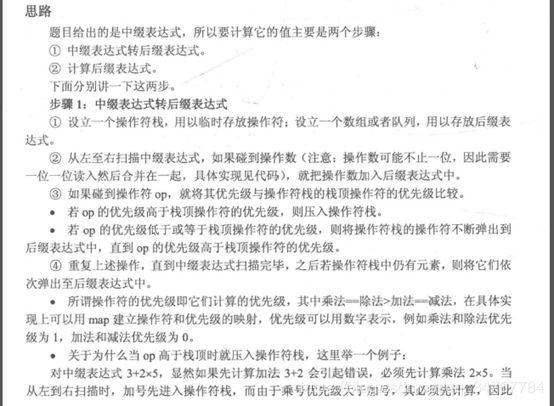- Leetcode刷题笔记——栈篇
code_lover_forever
Leetcode刷题笔记leetcode笔记算法python
Leetcode刷题笔记——栈篇栈的简介栈是一种先进后出的数据结构(FirstInLastOut),栈作为一种数据结构,是一种只能在一端进行插入和删除操作的特殊线性表,这里我不做过多介绍,栈的应用和练习算是面试中的高频考点了,接下来看下我们来看一下Leetcode关于栈的常见面试题题型,每道题都附上了简单明了的python解法,大家重点关注算法思想即可一、栈在括号匹配中的应用第一题:括号的最大嵌套
- 力扣刷题笔记 贪心篇
INlinKC
leetcode
总结先放在前面:贪心的本质是选择每一阶段的局部最优,从而达到全局最优。解答贪心时的一些小技巧与注意点:1.贪心问题在需要多维度进行考虑时,可以先从某一个维度开始贪心,然后再从另一个,比如NO.135.分发糖果中,既需要考虑左边孩子的糖果数又需要考虑右边孩子的糖果数,我们先从左往右保证右边一定大于左边,再从右往左保证左边一定大于右边(注意次数需要对比一下两次遍历中糖果数可能会不同,不同时需要去较大的
- 《算法笔记》学习日记——4.4 贪心
囷囷
《算法笔记》学习日记贪心算法算法c语言数据结构c++
目录4.4贪心问题A:看电视问题B:出租车费问题C:ToFillorNottoFill问题D:RepairtheWall问题E:FatMouse'sTrade问题F:迷瘴问题G:找零钱小结4.4贪心CodeupContestID:100000584问题A:看电视题目描述暑假到了,小明终于可以开心的看电视了。但是小明喜欢的节目太多了,他希望尽量多的看到完整的节目。现在他把他喜欢的电视节目的转播时间表
- 算法学习领域的宝藏
wylee
算法学习leetcode
labuladong的算法笔记仓库是算法学习领域的宝藏项目,它围绕LeetCode题目,以培养算法思维为核心,提供丰富学习资源与多种实用工具,助力学习者提升算法能力。项目核心内容:仓库包含60多篇原创文章,基于LeetCode题目展开,全面覆盖各种算法题型与技巧,旨在培养学习者的算法思维,避免单纯的代码堆砌。文章注重思路解释和思维框架构建,通过总结算法套路,帮助学习者少走弯路。学习资源与工具算法可
- 【力扣hot100】python刷题笔记之哈希
Animato.
哈希算法leetcode笔记
1.两数之和(简单)题目描述:给定一个整数数组nums和一个整数目标值target,请你在该数组中找出和为目标值target的那两个整数,并返回它们的数组下标。你可以假设每种输入只会对应一个答案,并且你不能使用两次相同的元素。你可以按任意顺序返回答案。示例:解法一:暴力解法:双层循环(这里就不给代码了)解法二:哈希表(时间复杂度O(n))算法思路:(1)先创建一个空字典当做哈希表来存储已经遍历过的
- 【算法笔记】红黑树插入操作
PXM的算法星球
算法笔记算法笔记
红黑树插入与调整详解一、红黑树的五大性质红黑树是一种自平衡的二叉搜索树(BST),其核心特性如下:颜色属性:每个节点非红即黑根属性:根节点必须为黑色叶子属性:所有的NIL叶子节点都是黑色红节点约束:红色节点的子节点必须为黑色(即无连续红节点)黑高平衡:从任一节点到其所有后代叶子节点的路径中,黑色节点数量相等二、插入操作流程阶段1:标准BST插入从根节点开始查找插入位置新节点总是红色按照BST规则插
- Java 集合list 手搓底层源码
好学且牛逼的马
算法
#32Java八股集合基础用法掌握速通小林不是很全老韩详细底层byd课程质量一般八股文听书算法题不会写byd密码的还没开始看双指针技巧秒杀七道链表题目|labuladong的算法笔记等等熬夜看笔记实现底层代码后面非常长但是也只写到了list完map和set明天写collection这段代码展示了Java集合框架的核心接口层次结构。`Collection`是整个集合框架的根接口,定义了集合操作的基本
- 洛谷刷题笔记——P3953 [NOIP2017 提高组] 逛公园
参考资料:洛谷_风休住大佬的题解[NOIP2017提高组]逛公园题目描述策策同学特别喜欢逛公园。公园可以看成一张NNN个点MMM条边构成的有向图,且没有自环和重边。其中111号点是公园的入口,NNN号点是公园的出口,每条边有一个非负权值,代表策策经过这条边所要花的时间。策策每天都会去逛公园,他总是从111号点进去,从NNN号点出来。策策喜欢新鲜的事物,它不希望有两天逛公园的路线完全一样,同时策策还
- 算法日常刷题笔记(7)
第一天字符串反转字符串及其反转中是否存在同一子字符串https://leetcode.cn/problems/existence-of-a-substring-in-a-string-and-its-reverse/给你一个字符串s,请你判断字符串s是否存在一个长度为2的子字符串,在s反转后的字符串中也出现。如果存在这样的子字符串,返回true;如果不存在,返回false。boolisSubstr
- LeetCode刷题笔记(Java实现)-- 35. 搜索插入位置
挽风归
leetcodejava算法
题目难度:Easy题目要求:给定一个排序数组和一个目标值,在数组中找到目标值,并返回其索引。如果目标值不存在于数组中,返回它将会被按顺序插入的位置。请必须使用时间复杂度为O(logn)的算法。示例1:输入:nums=[1,3,5,6],target=5输出:2算法思路:1、要求是时间复杂度为O(logn),则想到二分法;2、考虑特殊情况,若目标值应该插入数组最右端时,ans=nums.length
- 一站式解决:H5开发全攻略,看这篇让你省时又省力
linwu-hi
javascriptecmascript前端腾讯大厂H5H5开发
点击在线阅读,体验更好链接现代JavaScript高级小册链接深入浅出Dart链接现代TypeScript高级小册链接linwu的算法笔记链接在腾讯做的是H5开发相关的项目,也就是做了很久的切图仔了,分享些H5相关的踩坑经验响应式布局在H5中,我们通常会使用REM和VW这两种单位来实现页面的响应式布局。这两种单位可以让页面元素的大小随着根元素(对于REM)或视口宽度(对于VW)的大小变化而变化,从
- 力扣刷题笔记-35.搜索插入位置
KingsZySSS
力扣刷题笔记leetcode笔记算法
给定一个排序数组和一个目标值,在数组中找到目标值,并返回其索引。如果目标值不存在于数组中,返回它将会被按顺序插入的位置。请必须使用时间复杂度为O(logn)的算法。示例1:输入:nums=[1,3,5,6],target=5输出:2示例2:输入:nums=[1,3,5,6],target=2输出:1示例3:输入:nums=[1,3,5,6],target=7输出:4解题思路:同二分查找,假设题意是
- 【算法笔记】树套树
PXM的算法星球
算法笔记算法笔记
一、前言在面对二维区间统计问题时,比如:查询某个一维区间中,大于某个值的数的个数对一个序列同时支持区间查询+单点修改我们常用的一维数据结构(如线段树、树状数组)往往显得力不从心。此时,我们可以考虑一种高效的数据结构组合:树套树。二、什么是树套树?“树套树”顾名思义,就是一棵树中的每个节点再套一棵树。最常见的树套树结构是:外层:线段树/树状数组,按照下标维护区间内层:平衡树(如STLmultiset
- 算法笔记 01 —— C/C++快速入门
东方芷兰
算法笔记算法笔记c语言c++
前言本系列为胡凡编著的算法笔记当中代码部分的精简版整理,笔者也在同时准备Leetcode刷题和实习面试,希望为有一定编码和数据结构基础的同学提供一份系统型的参考,以方便遗忘时的算法查阅、期末复习总览以及C++学习参照。目录前言01基本数据类型02顺序结构03选择结构04循环结构05数组06函数07指针08结构体09补充01基本数据类型//变量变量类型变量名;变量类型变量名=初值;intnum=1;
- 0020算法笔记动态规划最优二叉搜索树问题资源介绍
傅阳轩
0020算法笔记动态规划最优二叉搜索树问题资源介绍【下载地址】0020算法笔记动态规划最优二叉搜索树问题资源介绍本项目深入探讨了动态规划在最优二叉搜索树问题中的应用,通过详细的问题分析和实例展示,帮助读者掌握动态规划的核心原理。内容涵盖问题背景、动态规划方法及其具体应用,并配有案例分析,直观呈现解题过程。适合有一定编程基础且对算法感兴趣的读者,旨在提升其解决实际问题的能力,助力算法学习与应用的进阶
- LeetCode Java刷题笔记—141. 环形链表
刘Java
链表leetcodejava141.环形链表
141.环形链表给你一个链表的头节点head,判断链表中是否有环。这道题可以说是快慢指针方式的入门题目,只要明白了快慢指针,这道题就很好解。所谓快慢指针,可以类比两个人从同一个起点沿着同一路线一直向前跑,其中一个跑得快,另一个跑得慢。,如果这条路线有环,并且一直跑下去,那么跑得快的人一定可以和跑得慢的在某一个点相遇,另一个常见的例子就是在操场跑步的时候,如果不设终点一直跑下去,那么跑得快的人肯定可
- 算法笔记|Day38动态规划XI
jluMR2019
算法笔记Java算法笔记动态规划
算法笔记|Day38动态规划XI☆☆☆☆☆leetcode1143.最长公共子序列题目分析代码☆☆☆☆☆leetcode1035.不相交的线题目分析代码☆☆☆☆☆leetcode53.最大子序和题目分析代码☆☆☆☆☆leetcode392.判断子序列题目分析代码☆☆☆☆☆leetcode1143.最长公共子序列题目链接:leetcode1143.最长公共子序列题目分析首先将text1和text2转
- LeetCode刷题笔记第58题:最后一个单词的长度
等风来随风飘
LeetCode刷题leetcode算法容器
LeetCode刷题笔记第58题:最后一个单词的长度想法:要找到最后一个单词的长度,先将字符串中的单词进行分割,通过split默认为所有的空字符,包括空格、换行(\n)、制表符(\t)等,如果最后一个单词存在则返回最后一个单词的长度。classSolution:deflengthOfLastWord(self,s:str)->int:#最后一个单词的长度#通过使用split,以空格来分割字符串s=
- 《算法笔记》13.2小节——专题扩展->树状数组(BIT) 问题 A: 最少的交换
圣保罗的大教堂
《算法笔记》算法
题目描述现在给你一个由n个互不相同的整数组成的序列,现在要求你任意交换相邻的两个数字,使序列成为升序序列,请问最少的交换次数是多少?输入输入包含多组测试数据。每组输入第一行是一个正整数n(n#include#include#include#include#include#include#include#include#include#include#include#include#defineIN
- 《算法笔记》13.2小节——专题扩展->树状数组(BIT) 问题 C: Count Inversions
圣保罗的大教堂
《算法笔记》算法
题目描述给一个数组,算invertedpair的数目输入有多组测试样例。每组输入数据占一行,每一行是一个数组,数组之间的元素用空格分开输出每组输出结果占一行。对应于每组输入数据的inversions样例输入123213321样例输出013分析:给出一个数组,求逆序数。思路和A类似,同样用归并的方法做了。#include#include#include#include#include#include
- 《算法笔记》12.2小节——字符串专题->KMP算法 问题 C: 剪花布条
圣保罗的大教堂
《算法笔记》算法
题目描述一块花布条,里面有些图案,另有一块直接可用的小饰条,里面也有一些图案。对于给定的花布条和小饰条,计算一下能从花布条中尽可能剪出几块小饰条来呢?输入输入中含有一些数据,分别是成对出现的花布条和小饰条,其布条都是用可见ASCII字符表示的,可见的ASCII字符有多少个,布条的花纹也有多少种花样。花纹条和小饰条不会超过1000个字符长。如果遇见#字符,则不再进行工作。输出输出能从花纹布中剪出的最
- Leetcode刷题笔记——二叉树篇
code_lover_forever
Leetcode刷题笔记深度优先leetcode笔记python
Leetcode刷题笔记——二叉树篇一、前言DFS是可一个方向去搜,不到黄河不回头,直到遇到绝境了,搜不下去了,再换方向(换方向的过程就涉及到了回溯,本文没有涉及太多和回溯相关的案例,对回溯相关的可以参考博主的另一篇文章)。BFS是先把本节点所连接的所有节点遍历一遍,走到下一个节点的时候,再把连接节点的所有节点遍历一遍,搜索方向更像是广度,四面八方的搜索过程。再讲DFS之前,我们得好好谈一谈递归,
- 《算法笔记》13.1小节——专题扩展->分块思想 问题 A: 区间查询
圣保罗的大教堂
《算法笔记》算法
题目描述食堂有N个打饭窗口,现在正到了午饭时间,每个窗口都排了很多的学生,而且每个窗口排队的人数在不断的变化。现在问你第i个窗口到第j个窗口一共有多少人在排队?输入输入的第一行是一个整数T,表示有T组测试数据。每组输入的第一行是一个正整数N(N#include#include#include#include#include#include#include#include#include#inclu
- 记录算法笔记(2025.5.22)岛屿数量
不知名小菜鸡.
笔记javascript开发语言
给你一个由'1'(陆地)和'0'(水)组成的的二维网格,请你计算网格中岛屿的数量。岛屿总是被水包围,并且每座岛屿只能由水平方向和/或竖直方向上相邻的陆地连接形成。此外,你可以假设该网格的四条边均被水包围。示例1:输入:grid=[["1","1","1","1","0"],["1","1","0","1","0"],["1","1","0","0","0"],["0","0","0","0","0
- Leetcode刷题笔记1 贪心算法part04
平乐君
leetcode刷题笔记1leetcode笔记贪心算法
leetcode452用最小数量的箭引爆气球本题被如何更新边界考住了classSolution:deffindMinArrowShots(self,points:List[List[int]])->int:iflen(points)==1:return1result=1points.sort(key=lambdax:x[0])foriinrange(1,len(points)):ifpoints[
- 《算法笔记》11.8小节——动态规划专题->总结 问题 D: Coincidence
圣保罗的大教堂
《算法笔记》动态规划
题目描述Findalongestcommonsubsequenceoftwostrings.输入Firstandsecondlineofeachinputcasecontaintwostringsoflowercasecharactera…z.Therearenospacesbefore,insideorafterthestrings.Lengthsofstringsdonotexceed100.
- 记录算法笔记(2025.5.19)二叉搜索树中第k小的元素
不知名小菜鸡.
算法笔记java
给定一个二叉搜索树的根节点root,和一个整数k,请你设计一个算法查找其中第k小的元素(从1开始计数)。示例1:输入:root=[3,1,4,null,2],k=1输出:1示例2:输入:root=[5,3,6,2,4,null,null,1],k=3输出:3提示:树中的节点数为n。1list=newList();publicintKthSmallest(TreeNoderoot,intk){//遍
- PAT B1001-算法笔记顺序P85
warmeyes
PAT算法笔记PAT算法笔记
1001害死人不偿命的(3n+1)猜想(15分)卡拉兹(Callatz)猜想:对任何一个正整数n,如果它是偶数,那么把它砍掉一半;如果它是奇数,那么把(3n+1)砍掉一半。这样一直反复砍下去,最后一定在某一步得到n=1。卡拉兹在1950年的世界数学家大会上公布了这个猜想,传说当时耶鲁大学师生齐动员,拼命想证明这个貌似很傻很天真的命题,结果闹得学生们无心学业,一心只证(3n+1),以至于有人说这是一
- LeeCode刷题笔记
Livan.Tang
C++笔记c++
编程语言基础课|代码随想录LeetCode热题100-学习计划-力扣(LeetCode)全球极客挚爱的技术成长平台CSONCodeTop面试题目总结https://leetcode.com/problemset/(英文官方题库)基础语法-01-20|阿秀的学习笔记10天刷题计划✅刷题策略:“核心题型+高频覆盖+模板记忆”一、优先刷高频面试题把握住80%公司爱问的题型,覆盖最常见的数据结构和算法套路
- 【算法笔记】ACM数论基础模板
寂空_
算法笔记算法笔记c++
目录几个定理唯一分解定理鸽巢原理(抽屉原理)麦乐鸡定理哥德巴赫猜想容斥原理例题二进制枚举解dfs解裴蜀定理例题代码最大公约数、最小公倍数最大公约数最小公倍数质数试除法判断质数分解质因数筛质数朴素筛法(埃氏筛法)线性筛法(欧拉筛法)约数试除法求约数求约数个数一个数求约数个数求1~n所有数的约数个数O(nlogn)O(nlogn)O(nlogn)筛法O(n)O(n)O(n)筛法约数之和一个数求约数之和
- java工厂模式
3213213333332132
java抽象工厂
工厂模式有
1、工厂方法
2、抽象工厂方法。
下面我的实现是抽象工厂方法,
给所有具体的产品类定一个通用的接口。
package 工厂模式;
/**
* 航天飞行接口
*
* @Description
* @author FuJianyong
* 2015-7-14下午02:42:05
*/
public interface SpaceF
- nginx频率限制+python测试
ronin47
nginx 频率 python
部分内容参考:http://www.abc3210.com/2013/web_04/82.shtml
首先说一下遇到这个问题是因为网站被攻击,阿里云报警,想到要限制一下访问频率,而不是限制ip(限制ip的方案稍后给出)。nginx连接资源被吃空返回状态码是502,添加本方案限制后返回599,与正常状态码区别开。步骤如下:
- java线程和线程池的使用
dyy_gusi
ThreadPoolthreadRunnabletimer
java线程和线程池
一、创建多线程的方式
java多线程很常见,如何使用多线程,如何创建线程,java中有两种方式,第一种是让自己的类实现Runnable接口,第二种是让自己的类继承Thread类。其实Thread类自己也是实现了Runnable接口。具体使用实例如下:
1、通过实现Runnable接口方式 1 2
- Linux
171815164
linux
ubuntu kernel
http://kernel.ubuntu.com/~kernel-ppa/mainline/v4.1.2-unstable/
安卓sdk代理
mirrors.neusoft.edu.cn 80
输入法和jdk
sudo apt-get install fcitx
su
- Tomcat JDBC Connection Pool
g21121
Connection
Tomcat7 抛弃了以往的DBCP 采用了新的Tomcat Jdbc Pool 作为数据库连接组件,事实上DBCP已经被Hibernate 所抛弃,因为他存在很多问题,诸如:更新缓慢,bug较多,编译问题,代码复杂等等。
Tomcat Jdbc P
- 敲代码的一点想法
永夜-极光
java随笔感想
入门学习java编程已经半年了,一路敲代码下来,现在也才1w+行代码量,也就菜鸟水准吧,但是在整个学习过程中,我一直在想,为什么很多培训老师,网上的文章都是要我们背一些代码?比如学习Arraylist的时候,教师就让我们先参考源代码写一遍,然
- jvm指令集
程序员是怎么炼成的
jvm 指令集
转自:http://blog.csdn.net/hudashi/article/details/7062675#comments
将值推送至栈顶时 const ldc push load指令
const系列
该系列命令主要负责把简单的数值类型送到栈顶。(从常量池或者局部变量push到栈顶时均使用)
0x02 &nbs
- Oracle字符集的查看查询和Oracle字符集的设置修改
aijuans
oracle
本文主要讨论以下几个部分:如何查看查询oracle字符集、 修改设置字符集以及常见的oracle utf8字符集和oracle exp 字符集问题。
一、什么是Oracle字符集
Oracle字符集是一个字节数据的解释的符号集合,有大小之分,有相互的包容关系。ORACLE 支持国家语言的体系结构允许你使用本地化语言来存储,处理,检索数据。它使数据库工具,错误消息,排序次序,日期,时间,货
- png在Ie6下透明度处理方法
antonyup_2006
css浏览器FirebugIE
由于之前到深圳现场支撑上线,当时为了解决个控件下载,我机器上的IE8老报个错,不得以把ie8卸载掉,换个Ie6,问题解决了,今天出差回来,用ie6登入另一个正在开发的系统,遇到了Png图片的问题,当然升级到ie8(ie8自带的开发人员工具调试前端页面JS之类的还是比较方便的,和FireBug一样,呵呵),这个问题就解决了,但稍微做了下这个问题的处理。
我们知道PNG是图像文件存储格式,查询资
- 表查询常用命令高级查询方法(二)
百合不是茶
oracle分页查询分组查询联合查询
----------------------------------------------------分组查询 group by having --平均工资和最高工资 select avg(sal)平均工资,max(sal) from emp ; --每个部门的平均工资和最高工资
- uploadify3.1版本参数使用详解
bijian1013
JavaScriptuploadify3.1
使用:
绑定的界面元素<input id='gallery'type='file'/>$("#gallery").uploadify({设置参数,参数如下});
设置的属性:
id: jQuery(this).attr('id'),//绑定的input的ID
langFile: 'http://ww
- 精通Oracle10编程SQL(17)使用ORACLE系统包
bijian1013
oracle数据库plsql
/*
*使用ORACLE系统包
*/
--1.DBMS_OUTPUT
--ENABLE:用于激活过程PUT,PUT_LINE,NEW_LINE,GET_LINE和GET_LINES的调用
--语法:DBMS_OUTPUT.enable(buffer_size in integer default 20000);
--DISABLE:用于禁止对过程PUT,PUT_LINE,NEW
- 【JVM一】JVM垃圾回收日志
bit1129
垃圾回收
将JVM垃圾回收的日志记录下来,对于分析垃圾回收的运行状态,进而调整内存分配(年轻代,老年代,永久代的内存分配)等是很有意义的。JVM与垃圾回收日志相关的参数包括:
-XX:+PrintGC
-XX:+PrintGCDetails
-XX:+PrintGCTimeStamps
-XX:+PrintGCDateStamps
-Xloggc
-XX:+PrintGC
通
- Toast使用
白糖_
toast
Android中的Toast是一种简易的消息提示框,toast提示框不能被用户点击,toast会根据用户设置的显示时间后自动消失。
创建Toast
两个方法创建Toast
makeText(Context context, int resId, int duration)
参数:context是toast显示在
- angular.identity
boyitech
AngularJSAngularJS API
angular.identiy 描述: 返回它第一参数的函数. 此函数多用于函数是编程. 使用方法: angular.identity(value); 参数详解: Param Type Details value
*
to be returned. 返回值: 传入的value 实例代码:
<!DOCTYPE HTML>
- java-两整数相除,求循环节
bylijinnan
java
import java.util.ArrayList;
import java.util.List;
public class CircleDigitsInDivision {
/**
* 题目:求循环节,若整除则返回NULL,否则返回char*指向循环节。先写思路。函数原型:char*get_circle_digits(unsigned k,unsigned j)
- Java 日期 周 年
Chen.H
javaC++cC#
/**
* java日期操作(月末、周末等的日期操作)
*
* @author
*
*/
public class DateUtil {
/** */
/**
* 取得某天相加(减)後的那一天
*
* @param date
* @param num
*
- [高考与专业]欢迎广大高中毕业生加入自动控制与计算机应用专业
comsci
计算机
不知道现在的高校还设置这个宽口径专业没有,自动控制与计算机应用专业,我就是这个专业毕业的,这个专业的课程非常多,既要学习自动控制方面的课程,也要学习计算机专业的课程,对数学也要求比较高.....如果有这个专业,欢迎大家报考...毕业出来之后,就业的途径非常广.....
以后
- 分层查询(Hierarchical Queries)
daizj
oracle递归查询层次查询
Hierarchical Queries
If a table contains hierarchical data, then you can select rows in a hierarchical order using the hierarchical query clause:
hierarchical_query_clause::=
start with condi
- 数据迁移
daysinsun
数据迁移
最近公司在重构一个医疗系统,原来的系统是两个.Net系统,现需要重构到java中。数据库分别为SQL Server和Mysql,现需要将数据库统一为Hana数据库,发现了几个问题,但最后通过努力都解决了。
1、原本通过Hana的数据迁移工具把数据是可以迁移过去的,在MySQl里面的字段为TEXT类型的到Hana里面就存储不了了,最后不得不更改为clob。
2、在数据插入的时候有些字段特别长
- C语言学习二进制的表示示例
dcj3sjt126com
cbasic
进制的表示示例
# include <stdio.h>
int main(void)
{
int i = 0x32C;
printf("i = %d\n", i);
/*
printf的用法
%d表示以十进制输出
%x或%X表示以十六进制的输出
%o表示以八进制输出
*/
return 0;
}
- NsTimer 和 UITableViewCell 之间的控制
dcj3sjt126com
ios
情况是这样的:
一个UITableView, 每个Cell的内容是我自定义的 viewA viewA上面有很多的动画, 我需要添加NSTimer来做动画, 由于TableView的复用机制, 我添加的动画会不断开启, 没有停止, 动画会执行越来越多.
解决办法:
在配置cell的时候开始动画, 然后在cell结束显示的时候停止动画
查找cell结束显示的代理
- MySql中case when then 的使用
fanxiaolong
casewhenthenend
select "主键", "项目编号", "项目名称","项目创建时间", "项目状态","部门名称","创建人"
union
(select
pp.id as "主键",
pp.project_number as &
- Ehcache(01)——简介、基本操作
234390216
cacheehcache简介CacheManagercrud
Ehcache简介
目录
1 CacheManager
1.1 构造方法构建
1.2 静态方法构建
2 Cache
2.1&
- 最容易懂的javascript闭包学习入门
jackyrong
JavaScript
http://www.ruanyifeng.com/blog/2009/08/learning_javascript_closures.html
闭包(closure)是Javascript语言的一个难点,也是它的特色,很多高级应用都要依靠闭包实现。
下面就是我的学习笔记,对于Javascript初学者应该是很有用的。
一、变量的作用域
要理解闭包,首先必须理解Javascript特殊
- 提升网站转化率的四步优化方案
php教程分享
数据结构PHP数据挖掘Google活动
网站开发完成后,我们在进行网站优化最关键的问题就是如何提高整体的转化率,这也是营销策略里最最重要的方面之一,并且也是网站综合运营实例的结果。文中分享了四大优化策略:调查、研究、优化、评估,这四大策略可以很好地帮助用户设计出高效的优化方案。
PHP开发的网站优化一个网站最关键和棘手的是,如何提高整体的转化率,这是任何营销策略里最重要的方面之一,而提升网站转化率是网站综合运营实力的结果。今天,我就分
- web开发里什么是HTML5的WebSocket?
naruto1990
Webhtml5浏览器socket
当前火起来的HTML5语言里面,很多学者们都还没有完全了解这语言的效果情况,我最喜欢的Web开发技术就是正迅速变得流行的 WebSocket API。WebSocket 提供了一个受欢迎的技术,以替代我们过去几年一直在用的Ajax技术。这个新的API提供了一个方法,从客户端使用简单的语法有效地推动消息到服务器。让我们看一看6个HTML5教程介绍里 的 WebSocket API:它可用于客户端、服
- Socket初步编程——简单实现群聊
Everyday都不同
socket网络编程初步认识
初次接触到socket网络编程,也参考了网络上众前辈的文章。尝试自己也写了一下,记录下过程吧:
服务端:(接收客户端消息并把它们打印出来)
public class SocketServer {
private List<Socket> socketList = new ArrayList<Socket>();
public s
- 面试:Hashtable与HashMap的区别(结合线程)
toknowme
昨天去了某钱公司面试,面试过程中被问道
Hashtable与HashMap的区别?当时就是回答了一点,Hashtable是线程安全的,HashMap是线程不安全的,说白了,就是Hashtable是的同步的,HashMap不是同步的,需要额外的处理一下。
今天就动手写了一个例子,直接看代码吧
package com.learn.lesson001;
import java
- MVC设计模式的总结
xp9802
设计模式mvc框架IOC
随着Web应用的商业逻辑包含逐渐复杂的公式分析计算、决策支持等,使客户机越
来越不堪重负,因此将系统的商业分离出来。单独形成一部分,这样三层结构产生了。
其中‘层’是逻辑上的划分。
三层体系结构是将整个系统划分为如图2.1所示的结构[3]
(1)表现层(Presentation layer):包含表示代码、用户交互GUI、数据验证。
该层用于向客户端用户提供GUI交互,它允许用户


